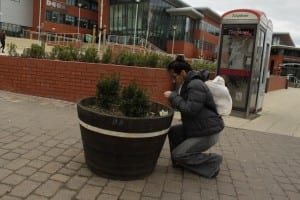METHODOLOGY- METHODS
In calling for multiple forms of observation, analysis and representation, the methodology of my research draws on middle ground-qualitative approaches, like Crystallization. Following Ellingson’s suggestion that
“Crystallization provides one effective approach to richly describing our findings and to making both overt and subtle manifestations of power in analytic, narrative/artistic, critical genres.”
I will see my research through a Richardson’s crystal that “reflects within themselves, creating different colours, patterns, and arrays, casting off in different directions.”
QUALITATIVE Methodology:
– An interest in meanings, perspectives and
understandings;
-An emphasis on process and interactions
-Triangulation of methods (usually 3 methods to
support findings)
CRYSTALLIZATION:
- Offer deep, thickly described, complexly rendered interpretations of meanings about a phenomenon or group.
- Represent ways of producing knowledge across multiple points of the qualitative continuum, generally including at least one middle-ground (constructivist or postpositivist) and one interpretive, artistic, performative, or otherwise creative analytic approach; often crystallized texts reflect several contrasting ways of knowing.
- Utilize more than one genre of writing (e.g., poetry, narrative, report) and/or other medium (e.g., video, painting, music).
- Include a significant degree of reflexive consideration of the researcher’s self and roles in the process of research design, data collection, and representation.
- Eschew positivist claims to objectivity and a singular, discoverable Truth in favor of embracing knowledge as situated, partial, constructed, multiple, embodied, and enmeshed in power relations.
More specifically, I intend to proceed to my research by using:
a) (hetero)Phenomenology to pursue information regarding embodied experiences of others -photographers in action- through observation,mapping, documenting their process and interviews. Phenomenology focuses on experiences of the
body/embodiment.
“…the first moment of phenomenology originates in doing, but accompanying this doing is a weaving in and out of a link or thought, a line of questioning? (Kozel, 2007, p51).
Phenomenology (Kozel, 2007) :
-Take attention to this moment.
-Suspend the main flow of thought.
-Call your attention to your body and what it is experiencing (are you short of breath, is your back hurting, are you hungry?)
-Witness what you see, hear, and touch, how space feels and temperature and how the inside of your body feels in relation to the
outside… Register thoughts but do no delve… Your data depends on your context
-Take a break (a moment, a day, a week, a year).
-Describe what you experience. Take notes, record…
-Take a break.
-Reexamine your notes with an eye for what seems significant…set yourself the task of further research into ideas that relate to your
experience
“A phenomenological document can range from the scholarly to the more poetic and the document can be visual, physical, written or
spoken… An effect phenomenology provides enough concrete detail to resonate with the embodied experience of the targeted group of recipients and combines this with a level of theory or conceptual engagement that lends the experience to a wider relevance…? (Kozel,
2007, p.55).
-The heterophenomenologist is a situated researcher, who interprets what is experienced by another.
-It relies on shared experience or some degree of empathy.
-By understanding another we understand ourselves and perhaps a wider community.
b) auto-ethnographic performance for self reflection and witnessing of inward and outward self-experiences.
Autoethnography is an approach to research and writing that seeks to describe and systematically analyze personal experience in order to understand cultural experience. This approach challenges canonical ways of doing research and representing others and treats research as a political, socially-just and socially-conscious act. A researcher uses tenets of autobiography and ethnography to do and write autoethnography. Thus, as a method, autoethnography is both process and product. (Carolyn Ellis, Tony E. Adams & Arthur P. Bochner)
c) technological approaches that will help on tracing photographer’s movement in space.
Some of the methods I plan to use through my research are:
-written record either in the form of an online diary or blog, or a hand written
notebook.
-diary-video/photo documentation of the process.
-use of a blog, during the research process, to collect, reflect, share and receive feedback about the out coming materials and results.
-recordings of sounds of the photographic process.
-reading of texts in relation to the photographic process as source for further questions and inspirations.
-creation of body-maps and mind-maps.
-interviews for collecting information about the personal experiences of photographers in relation to their embodied experience.
-collection of exercises based on movement inspired forms and somatic practices, for physical exploration during the photographic process.








